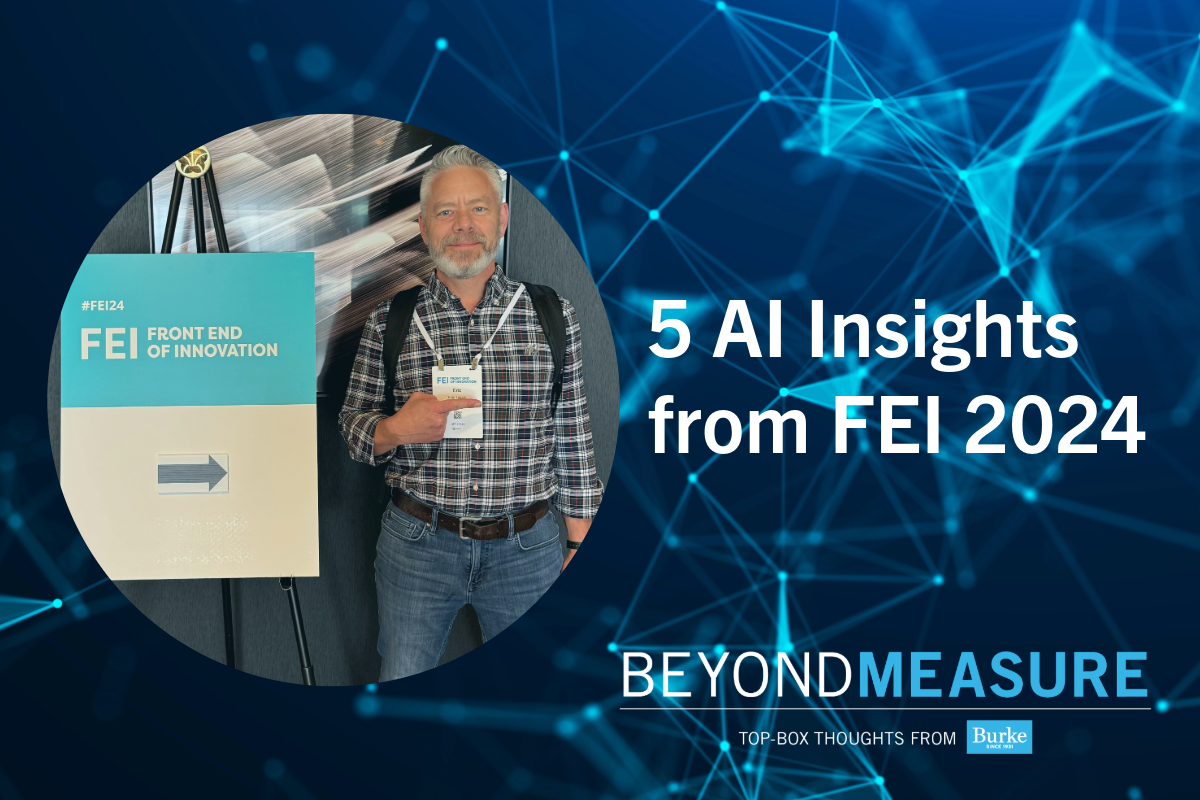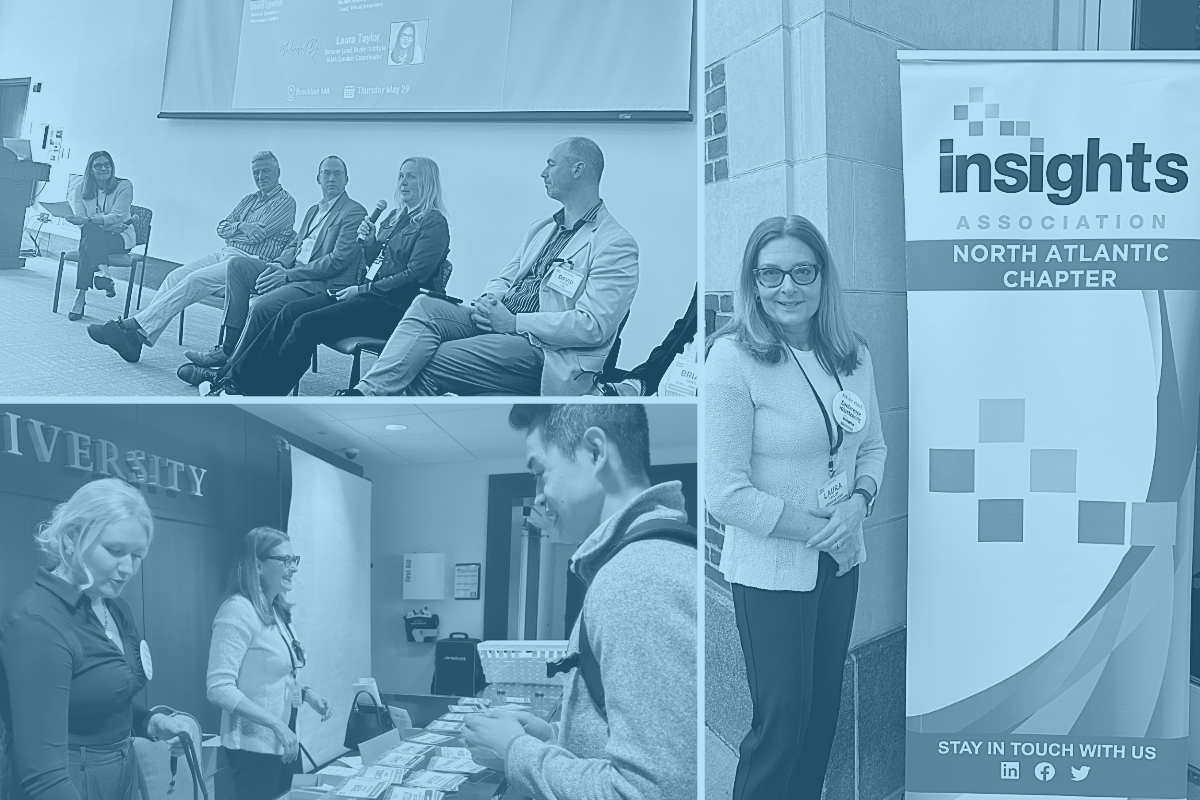
FRONT END OF INNOVATION 2024: FIVE AI INSIGHTS
by Eric Tayce
I recently had the pleasure of attending the Front End of Innovation conference in Boston, MA. The conference highlighted the importance of balancing AI capabilities with human expertise to drive consumer-centric strategies. It was a busy few days full of valuable insights into the transformative impact of artificial intelligence on the innovation process.
I distilled the perspectives I heard to five key AI-themed insights that are currently shaping the future of innovation.
FRONT END OF INNOVATION AI INSIGHT #1
Artificial intelligence has had an outsized impact on the innovation process.
The impact artificial intelligence has had on the innovation landscape is nothing less than transformative. The entire front end of the innovation process can now be executed without ever speaking to an end-user. In fact, in a presentation from a pair of Clorox innovators, consumers are not brought into the process until fully configured concepts are available. However, this Clorox team emphasized humans are still a necessary component in the process, and they supported this belief with data showing that innovations derived from AI-human collaboration consistently yielded the best results.
What it means to us.
Those of us in the insights industry have long recognized the need to keep the subject of interest (in our case, that would be the consumer) at the center of decision making. Artificial intelligence is a tool that offers new opportunities, the first of which is freedom to focus on the work we do best: understanding why people do the things they do. LLMs are probabilistic models, so they will always give you a response (regardless of the question). Analyst-Technology partnerships work because the Analyst delegates the right tasks to technology solutions and gives it the proper instructions for execution. AI is a data processing powerhouse that can identify patterns with unprecedented speed, but human insight and creativity are crucial for contextualizing these findings and crafting nuanced, consumer-centric strategies. It’s a balanced integration of AI and human expertise to enhance the human touch in innovation, not replace it.
FRONT END OF INNOVATION AI INSIGHT #2
Unstructured data takes center stage.
The ability to mine insights from unstructured data has placed qualitative research in the limelight. In fact, the Front End of Innovation conference had a notable skew towards qualitative research suppliers, with a ratio of approximately 3:2 compared to quantitative research suppliers. With the introduction of increasingly sophisticated LLMs, tech-heavy companies are touting an ability to “conduct qualitative at scale.” However, conversations with these vendors quickly revealed technology skills and experience, but a lack of survey research backgrounds. One vendor insisted his trained GPT had mastered focus group moderation and theme detection, but his explanations of process showed he lacked the practical knowledge of how to find, recruit and conduct unbiased research.
What it means to us.
The insights hidden in unstructured data have long been a challenge for organizations to uncover, and the rush to plant a flag in this space is understandable. Artificial intelligence has opened a huge door to opportunity, but client-side innovators should remain guarded. While technology offers exciting possibilities for scaling qualitative insights, failing to balance this with deep research expertise opens an equally large door to misinformation. Leveraging qualitative research requires a nuanced understanding of human behavior and context, and a nuanced ability to deal with real humans discussing unmet needs and desires. While AI is clearly impressive, it cannot effectively redirect an errant conversation driven by a talkative participant, or coax an introvert to reveal that one nugget of insight that changes everything.
FRONT END OF INNOVATION AI INSIGHT #3
It takes an ecosystem to maximize the value of AI.
Client-side presenters at the Front End of Innovation conference emphasized the importance of collaborating with various stakeholders within their ecosystems, including technology vendors, research providers, consultants, and more, to drive breakthrough innovations. Most client presenters admitted to having only a surface-level understanding of the underlying technologies, heavily relying on their vendors for execution. This dependence implies that all players in this space must enhance their technological capabilities to remain competitive and to be considered essential partners in the innovation process. In the short term, a strong technological proficiency can serve as a significant competitive advantage.
What it means to us.
The emphasis on ecosystem collaboration for achieving breakthrough innovations is widely recognized across our company. Understanding the power of leveraging the breadth of expertise that exists outside of a company is key. However, equally important are the completeness of frameworks used to evaluate and select strategic partners to ensure expected levels of quality. While this may seem like hard work on the front end, it’s critical to delivering seamless, technologically-advanced solutions that empower clients to achieve their innovation objectives with confidence.
FRONT END OF INNOVATION AI INSIGHT #4
Innovators understand the importance of taking risks.
Innovation experts understand the importance of being first to the market. They tend to have a higher tolerance for making resource investments with limited information and with fewer boundaries. Maximiliano Just, the Global VP of Data Governance and Shared Platforms at Coca-Cola, used his love of race cars to emphasize that pushing initiatives to the point of failure is essential for learning and improvement. It is this willingness to take risks that has accelerated the enthusiastic adoption of artificial intelligence (a technology still in its infancy) within the innovation space.
What it means to us.
A willingness to fail does not translate into a tolerance for quality shortcuts or blindly accepting sub-standard work. It means we have a responsibility to establish rigorous methods for uncovering risk so that it is known, quantified (when possible), and attenuated when drawing insights and making recommendations. It is important to push the envelope with AI to drive innovation, but only when eyes are wide open. To that end, establishing and integrating best practices into systems and ensuring that there is always a human counterpart with industry expertise involved remains critical to success. Doing so allows us to find the “edges” and achieve innovative solutions that are truly groundbreaking.
FRONT END OF INNOVATION AI INSIGHT #5
Speed is paramount.
Companies must move at the speed of innovation, a concept that, while it may sound cliché, reflects the intense pressure innovation experts feel to deliver results rapidly. Consequently, solutions that promise faster results can look highly attractive to experts in this space. In fact, one big “ta-da” moment at the Front End of Innovation conference came from Clorox representatives discussing an AI-generated idea that was on shelves in just 9 months (a process that normally takes them 3 years). Clorox was not alone, of course; many client-side presenters focused on the speed-to-market as a top driver for AI adoption, and as proof of its success.
What it means to us.
With decades of experience in the innovation space, we are more than familiar with the maxim “if you aren’t first, it isn’t innovation.” Speed is always a factor, and becoming more critical with each new upgrade to this emerging technology. Using AI to enhance and accelerate decision support at every stage in the innovation pipeline is one way to streamline processes and significantly reduce time to market. It’s a measured approach that ensures solutions not only meet the demand for speed but also maintain the highest standards of quality and efficacy.
As I’ve said, artificial intelligence has had an outsized impact on this space, but I don’t want to sell the message too far. AI hasn’t changed the core principles of innovation any more than microwaves changed food; they just gave us a faster way to cook.

Eric Tayce is VP, Innovation Solutions at Burke. With over 20 years in the industry, Eric has experience that spans the entire research process from the perspectives of both a supplier and a client. Eric’s expertise covers many business issues, with particular emphasis on brand equity, brand image and positioning, segmentation, and product optimization.
Interested in reading more? Check out Eric’s other article:
How Research Can Guide the Innovation Process
As always, you can follow Burke, Inc. on our LinkedIn, Twitter, Facebook and Instagram pages.








